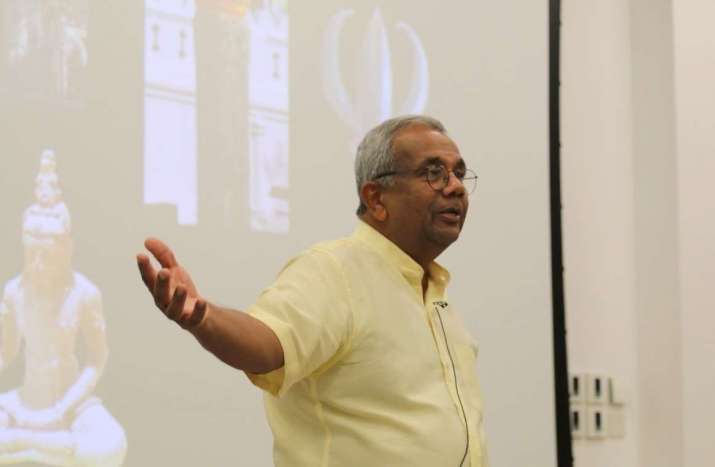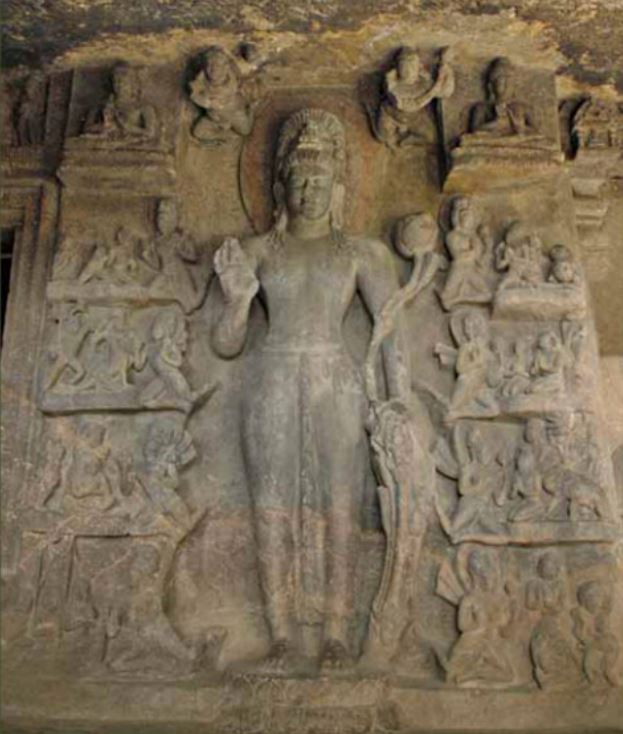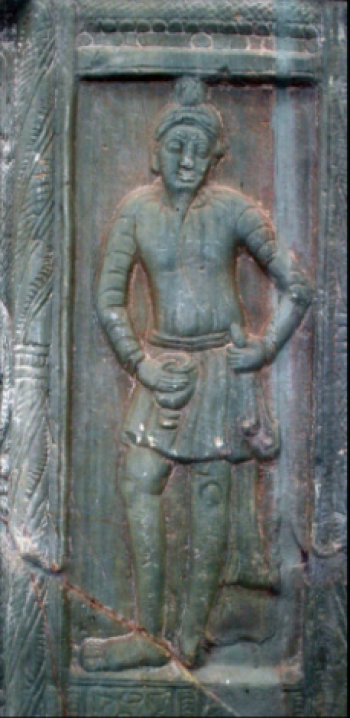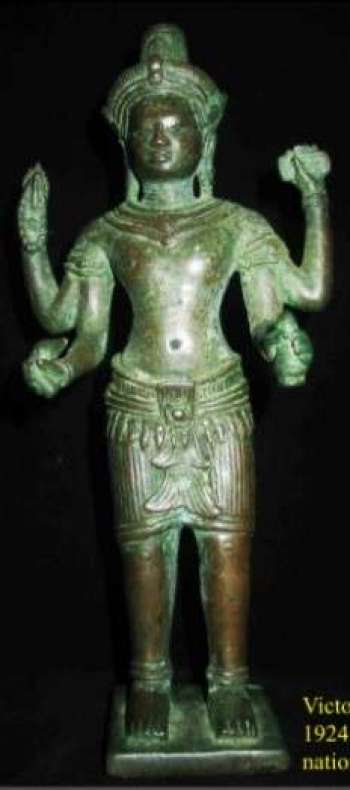
Professor Osmund Bopearachchi, adjunct professor of Central and South Asian art, archaeology, and numismatics at the University of California, Berkeley, and emeritus director of research at the French National Centre for Scientific Research, visited Hong Kong in July to deliver two lectures on Buddhist art at the University of Hong Kong’s Centre of Buddhist Studies. Prof. Bopearachchi is a numismatist (scholar of currency), historian, art historian, and archaeologist specializing in linking numismatics with sculptural and pictorial iconography in Central Asian and South Asian archaeology, art, and architecture.
In his first lecture, Prof. Bopearachchi charted the spread of Buddhism via trade routes in the Indian Ocean. When we talk about the ancient Silk Road, either the inland or maritime routes, people usually associate them with the trade of goods between East and West. However, fewer realize that the maritime and inland trade brought people from different cultures, languages, beliefs, and aesthetic aspirations together. In ancient times, traders not only facilitated economic growth between regions, but also triggered cultural exchanges—including the spread of Buddhism. As Prof. Bopearachchi noted, traders were mediators of cultural interactions. Buddhist monastics, philosophers, artists, and diplomats all traveled together with traders. Thus, not only goods but also philosophical thought and iconographies were exchanged.
One may believe that Buddhism stands purely for non-materialistic ideals, and thus opposes the generation of wealth. However, this is a misconception. As expressed by Prof. Bopearachchi, it is not an exaggeration to say that Buddhism encourages trade and appreciates donations from rich merchants. In fact, scholars have discovered hundreds of inscriptions announcing the contributions of traders to Buddhist institutions. In addition, Buddhist texts contain records admiring the donations made by rich merchants to Buddhist complexes. A well known example is Anathapindika, the wealthiest merchant in Savatthi in the time of Shakyamuni Buddha, who purchased Jetavana Park for the Buddha by covering the land with coins.
The spread of Buddhism from South Asia to Southeast Asia is closely connected with the growth of maritime and river trading networks. When we investigate the distribution of important Buddhist sites in India, Jave, Myanmar, Sri Lanka, and Thailand, we realize that they were inland and clustered around the big rivers flowing to the Indian Ocean. The prosperity and duration of their existence depended mainly on the dynamics of trade.
Avalokiteshvara (also known as Guanyin), the Bodhisattva of Compassion, gained much popularity due to his reputation of offering protection to traders. Many Buddhist caves in the Indian subcontinent have depictions of the Astamahabhaya Avalokiteshvara protecting humans from the eight great perils, among them, the danger of shipwrecks in the turbulent ocean.

sixth–seventh century. Image courtesy of Prof. Osmund Bopearachchi
The choice of Jataka and Avadana stories depicted in paintings and reliefs of Ajanta and many other Buddhist cave complexes reflects the aspirations of donors who sponsored them. In these stories we find depictions of sea monsters and terrestrial demons, major threats and enemies of mariners who ventured into perilous ocean and dangerous foreign lands in search of wealth. The Buddhist icons represent appeals for protection from the Buddha and bodhisattvas to ensure that trader-donors reached their homes safely.
One might be curious about exactly who these mariners, traders, and merchants were. Some extant mural paintings and sculptures help us to guess their identities. “Like today’s selfies, these generous traders have left their portraits in the Buddhist art sponsored by them,” Prof. Bopearachchi explained during his lecture. Apart from local traders, one also finds portraits of non-Indians traders. For example, the relief in a pillar of Nagarjunakonda has a depiction of a Scythian, shown wearing a long-sleeved tunic over tight trousers belted at the waist and wearing a Phrygian cap.
A new era of trade began between Rome and Sri Lanka during the reign of the Roman Emperor Claudius (r. 41–54 CE). During this time there was an accidental visit to Sri Lanka by Annius Plocamus, a Roman tax collector. A delegation was then sent from Sri Lanka to Rome. Archaeologists have found the mummy of Grottarossa, an eight-year-old Roman girl from the second century, wearing a gold necklace adorned with 13 blue sapphires from Sri Lanka. The interaction between the two regions also explains the Roman inspiration in Sri Lankan art.
From the seventh century onward, the Arab, Chinese, Persian, and South Indian merchants developed their trade with Sri Lanka and Southeast Asia. Sri Lanka began to play a decisive role in maritime trade between East and West at this time. It was during the peak of this movement between East and West that Avalokiteshvara and his consort Tara became popular as the protectors of sailors.
In 2015, scholars at the Center for Buddhist Studies, UC Berkeley, and the National Centre for Scientific Research (CNRS-ENS), Paris, in collaboration with the University of Rajarata, Mihintale, and the Department of Archaeology in Sri Lanka launched the Avalokiteshvara Survey Project. The project is aimed at investigating the relationship between Buddhism and maritime trade in Sri Lanka and beyond. Since its inception the project has discovered numerous hitherto-unknown inscriptions, images, and votive tablets denoting Mahayana concepts.
As noted by Prof. Bopearachchi, the most important discovery has been the Vajradhatu-mandala, studied at length by Kellie Powell of the Buddhist Studies Department at UC Berkeley, which shows the presence and practice of tantric Mahayana, or Vajrayana, in the Sri Lankan capital Anuradhapura in the eighth to 10th centuries. It is an unexpected surprise that tantric statues were discovered in various places in Sri Lanka.
The spread of Buddhism and Buddhist iconography from South Asia to Southeast Asia is closely connected with the growth of maritime networks. These networks facilitated the movements of Buddhist merchants, and traveling monks and teachers. Due to the development of trade, Buddhist iconography developed in a complex and cross-fertilized context, ingeniously incorporating the sentiments and aesthetics of respective populations. Instead of reproducing standard stereotypical prototypes, artists created new forms of art, leaving some traces of the aspirations of the donor-traders and enabling us to understand the growth of the maritime networks and the early spread of Buddhism.


See more
Professor Osmund Bopearachchi
Centre of Buddhist Studies, the University of Hong Kong






